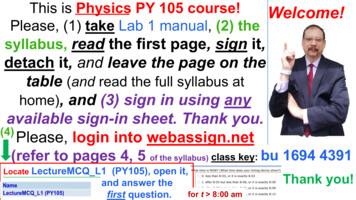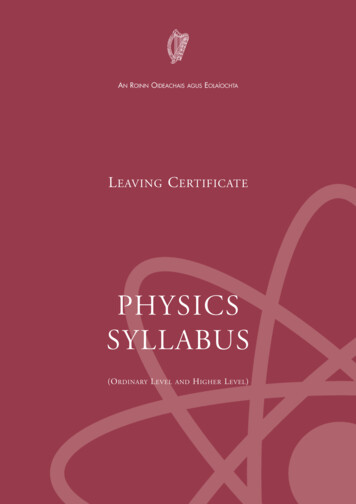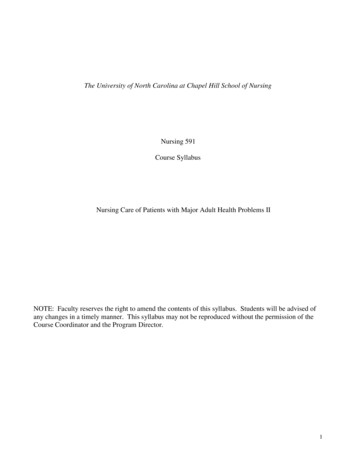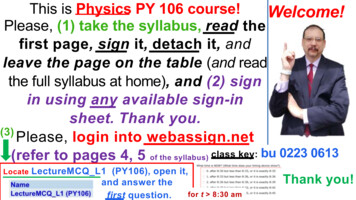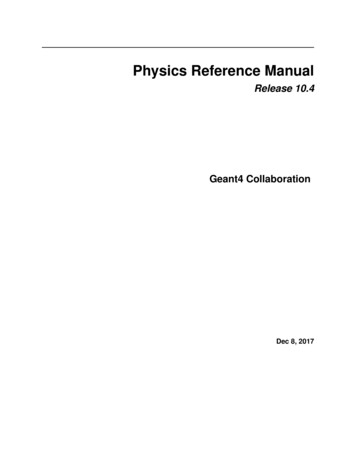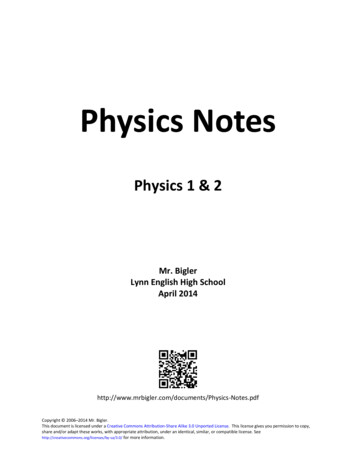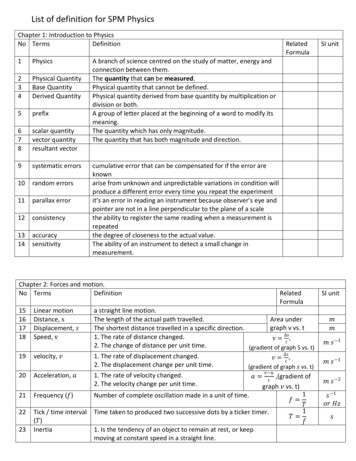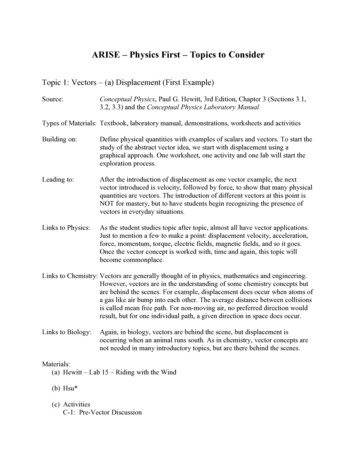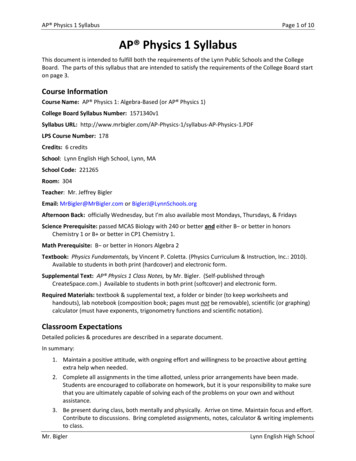
Transcription
AP Physics 1 SyllabusPage 1 of 10AP Physics 1 SyllabusThis document is intended to fulfill both the requirements of the Lynn Public Schools and the CollegeBoard. The parts of this syllabus that are intended to satisfy the requirements of the College Board starton page 3.Course InformationCourse Name: AP Physics 1: Algebra-Based (or AP Physics 1)College Board Syllabus Number: 1571340v1Syllabus URL: hysics-1.PDFLPS Course Number: 178Credits: 6 creditsSchool: Lynn English High School, Lynn, MASchool Code: 221265Room: 304Teacher: Mr. Jeffrey BiglerEmail: MrBigler@MrBigler.com or BiglerJ@LynnSchools.orgAfternoon Back: officially Wednesday, but I’m also available most Mondays, Thursdays, & FridaysScience Prerequisite: passed MCAS Biology with 240 or better and either B or better in honorsChemistry 1 or B or better in CP1 Chemistry 1.Math Prerequisite: B or better in Honors Algebra 2Textbook: Physics Fundamentals, by Vincent P. Coletta. (Physics Curriculum & Instruction, Inc.: 2010).Available to students in both print (hardcover) and electronic form.Supplemental Text: AP Physics 1 Class Notes, by Mr. Bigler. (Self-published throughCreateSpace.com.) Available to students in both print (softcover) and electronic form.Required Materials: textbook & supplemental text, a folder or binder (to keep worksheets andhandouts), lab notebook (composition book; pages must not be removable), scientific (or graphing)calculator (must have exponents, trigonometry functions and scientific notation).Classroom ExpectationsDetailed policies & procedures are described in a separate document.In summary:1. Maintain a positive attitude, with ongoing effort and willingness to be proactive about gettingextra help when needed.2. Complete all assignments in the time allotted, unless prior arrangements have been made.Students are encouraged to collaborate on homework, but it is your responsibility to make surethat you are ultimately capable of solving each of the problems on your own and withoutassistance.3. Be present during class, both mentally and physically. Arrive on time. Maintain focus and effort.Contribute to discussions. Bring completed assignments, notes, calculator & writing implementsto class.Mr. BiglerLynn English High School
AP Physics 1 SyllabusPage 2 of 104. If you are struggling, come in for extra help after school. Mr. Bigler’s official afternoon back isMonday. However, he is usually available after school every afternoon except for Tuesdays(which is when the Science Team meets), unless his presence is required at an after-schoolmeeting. (Please confirm his availability during the school day to make sure. Faculty meetingsare on the first Wednesday of every month; science department meetings are on the secondThursday of every month.)5. Do your own work on tests and quizzes. Cheating, copying or plagiarism will result in a zero andnotification of parent or guardian. More importantly, cheating will not help you learn anythingor pass the AP exam.6. Treat all staff, students, equipment and furniture appropriately and respectfully.7. Mr. Bigler does not use a lab safety contract—safety is required at all times and is not somethingyou have the option of agreeing to or not. Mr. Bigler will not micromanage your labexperiences, but he will make sure you know what the potential dangers are and how to keepyourself and everyone else safe. Safety violations may result in a disciplinary referral, loss of theprivilege of participating in the lab or activity (which may result in a failing grade) and/orpayment of restitution for damaged equipment.8. Adhere to all school rules, policies and procedures as published in the student handbook.GradesYour grade is calculated by the eSchool Plus grading system, based on the grade weights entered by Mr.Bigler. The grade weights are: Unit tests, formal lab reports, and major projects: 100 points Quizzes, lab write-ups, and minor projects: 50 points Participation in lab experiments: 25 points Homework & classwork assignments: 5 points Mid-term exam: 150 pointsMr. Bigler is responsible for entering grades and weights into eSchool Plus, but the grades themselvesare calculated by eSchool Plus. You are responsible for monitoring your grades through the HomeAccess Center (HAC).If you believe that your grade has been calculated incorrectly, it is your responsibility to bring it to Mr.Bigler’s attention. He will check the calculation manually and adjust your grade as appropriate.HomeworkHomework is due at the beginning of class and will be graded (5 points) or (4 points), based onhow much of the homework you attempted (with work shown). Retrieving your homework from yourlocker after class has started costs 1 point. Late work is worth 3 points if turned in before the unit teston the topic, and 2 points afterwards, provided that it is 100% complete and has correct answers and allwork shown. Students who are in the building at any time during the school day (even if they are on afield trip during physics class) are expected to turn in assignments on the due date.Attendance & Make-Up WorkAbsent students are expected to obtain and complete any assignments that they missed. Absentstudents are also expected to schedule make-up tests with Mr. Bigler within one week, unless otherarrangements are made on the day the student returns to school. According to LEHS policy, studentswho are absent from school seven or more times during a quarter (as calculated by TAC) receive a failinggrade for the quarter in all classes.Mr. BiglerLynn English High School
AP Physics 1 SyllabusPage 3 of 10Curricular RequirementsCR1Page(s)Students and teachers have access to college-level resources including college-leveltextbooks and reference materials in print or electronic format.4The course design provides opportunities for students to develop understanding of theCR2a foundational principles of kinematics in the context of the big ideas that organize thecurriculum framework.6The course design provides opportunities for students to develop understanding of theCR2b foundational principles of dynamics in the context of the big ideas that organize thecurriculum framework.6The course design provides opportunities for students to develop understanding of thefoundational principles of gravitation and circular motion in the context of the bigideas that organize the curriculum framework.6The course design provides opportunities for students to develop understanding of theCR2d foundational principles of simple harmonic motion in the context of the big ideas thatorganize the curriculum framework.6The course design provides opportunities for students to develop understanding of theCR2e foundational principles of linear momentum in the context of the big ideas thatorganize the curriculum framework.6CR2fThe course design provides opportunities for students to develop understanding of thefoundational principle of energy in the context of the big ideas that organize thecurriculum framework.6CR2gThe course design provides opportunities for students to develop understanding of thefoundational principles of rotational motion in the context of the big ideas thatorganize the curriculum framework.6The course design provides opportunities for students to develop understanding of theCR2h foundational principles of electrostatics in the context of the big ideas that organizethe curriculum framework.6CR2iThe course design provides opportunities for students to develop understanding of thefoundational principles of electric circuits in the context of the big ideas that organizethe curriculum framework.6CR2jThe course design provides opportunities for students to develop understanding of thefoundational principles of mechanical waves in the context of the big ideas thatorganize the curriculum framework.6CR3Students have opportunities to apply AP Physics 1 learning objectives connectingacross enduring understandings as described in the curriculum framework. Theseopportunities must occur in addition to those within laboratory investigations.7CR4The course provides students with opportunities to apply their knowledge of physicsprinciples to real world questions or scenarios (including societal issues ortechnological innovations) to help them become scientifically literate citizens.7CR2cMr. BiglerLynn English High School
AP Physics 1 SyllabusPage 4 of 10Curricular RequirementsPage(s)CR5Students are provided with the opportunity to spend a minimum of 25 percent ofinstructional time engaging in hands-on laboratory work with an emphasis on inquirybased investigations.8CR6aThe laboratory work used throughout the course includes investigations that supportthe foundational AP Physics 1 principles.8 7CR6bThe laboratory work used throughout the course includes guided-inquiry laboratoryinvestigations allowing students to apply all seven science practices.5 7CR7The course provides opportunities for students to develop their communication skillsby recording evidence of their research of literature or scientific investigations throughverbal, written, and graphic presentations.8CR8The course provides opportunities for students to develop written and oral scientificargumentation skills.7Course IntroductionTextbook:ndColetta, Vincent P. Physics Fundamentals. 2 Edition. Lakeville, MN:Physics Curriculum & Instruction, Inc., 2010. Available to students in bothprint and electronic formats. [CR1]Supplemental Text: Mr. Bigler. Class Notes for AP Physics 1. Selfpublished through CreateSpace.com. Available to students in both print andelectronic formats.Mr. BiglerCR1: Students andteachers have access tocollege-level resourcesincluding college-leveltextbooks and referencematerials in print orelectronic format.Lynn English High School
AP Physics 1 SyllabusPage 5 of 10About this course:The AP Physics 1 course meets for five periods of 48 minutes each plus onecontiguous 90-minute period for lab work in each seven-day cycle. [CR5] Labwork is integral to the understanding of the concepts in AP Physics 1, whichhas been designed by the College Board as a course equivalent to the algebrabased college-level physics class. At the end of the course, students will takethe AP Physics 1 Exam, which will test their knowledge and ability to apply theconcepts taught in the classroom and learned through experimentation.CR5: Students are providedwith the opportunity tospend a minimum of25 percent of instructionaltime engaging in hands-onlaboratory work with anemphasis on inquiry-basedinvestigations.The content for the course is based on six big ideas: Big Idea 1 – Objects and systems have properties such as mass andcharge. Systems may have internal structure. Big Idea 2 – Fields existing in space can be used to explain interactions. Big Idea 3 – The interactions of an object with other objects can bedescribed by forces. Big Idea 4 – Interactions between systems can result in changes in thosesystems. Big Idea 5 – Changes that occur as a result of interactions areconstrained by conservation laws. Big Idea 6 – Waves can transfer energy and momentum from onelocation to another without the permanent transfer of massand serve as a mathematical model for the description ofother phenomena.Evaluation:Students will be graded on homework, quizzes, laboratory work, projects, andexams. Exams and will consist of questions similar to the ones students will seeon the AP Exam. Homework assignments and quizzes will consist of problemsfrom the textbook, supplements, and old AP Exams. Projects are long-term, andtypically will involve groups of students developing a plan, collecting dataand/or research, and presenting conclusions in a meaningful way. Laboratorywork is student-centered and inquiry-based, as discussed below.Grades will be determined based on students’ completion of homework,performance on tests and quizzes, and quality of content and writing forlaboratory reports.Mr. BiglerLynn English High School
AP Physics 1 SyllabusPage 6 of 10Topics Covered:1. Kinematics (Big Idea 3)a. Vectors/Scalars [CR2a]b. One-Dimensional Motion (including graphing position,velocity, and acceleration) [CR2a]c. Two-Dimensional Motion [CR2a]d. Rotational Kinematics [CR2g]2. Dynamics (Big Ideas 1, 2, 3, and 4)a. Newton’s Laws of Motion and Forces [CR2b]b. Torque and Rotational Dynamics [CR2g]3. Universal Law of Gravitation (Big Ideas 1, 2, 3, and 4)a. Circular Motion [CR2c]4. Simple Harmonic Motion (Big Ideas 3 and 5)a. Simple Pendulums [CR2d]b. Mass-Spring Oscillators [CR2d]5. Momentum (Big Ideas 3, 4, and 5)a. Impulse and Momentum [CR2e]b. The Law of Conservation of Momentum [CR2e]c. Angular Momentum [CR2g]d. Conservation of Angular Momentum [CR2g]6. Energy (Big Ideas 3, 4, and 5)a. Work [CR2f]b. Energy [CR2f]c. Conservation of Energy [CR2f]d. Power [CR2f]e. Rotational Energy [CR2g]7. Electrostatics (Big Ideas 1, 3, and 5)a. Electric Charge [CR2h]b. The Law of Conservation of Electric Charge [CR2h]c. Electrostatic Forces [CR2h]8. Circuits (Big Ideas 1 and 5)a. Ohm’s Law [CR2i]b. Kirchhoff’s Laws [CR2i]c. Simple DC Circuits [CR2i]9. Mechanical Waves and Sound (Big Idea 6) [CR2j]CR2g: The course designprovides opportunities forstudents to developunderstanding of thefoundational principles ofrotational motion in thecontext of the big ideasthat organize thecurriculum framework.CR2h: The course designprovides opportunities forstudents to developunderstanding of thefoundational principles ofelectrostatics in thecontext of the big ideasthat organize thecurriculum framework.CR2i: The course designprovides opportunities forstudents to developunderstanding of thefoundational principles ofelectric circuits in thecontext of the big ideasthat organize thecurriculum framework.CR2a: The course designprovides opportunities forstudents to developunderstanding of thefoundational principles ofkinematics in the contextof the big ideas thatorganize the curriculumframework.CR2b: The course designprovides opportunities forstudents to developunderstanding of thefoundational principles ofdynamics in the context ofthe big ideas that organizethe curriculum framework.CR2c: The course designprovides opportunities forstudents to developunderstanding of thefoundational principles ofgravitation and circularmotion in the context ofthe big ideas that organizethe curriculum framework.CR2d: The course designprovides opportunities forstudents to developunderstanding of thefoundational principles ofsimple harmonic motion inthe context of the big ideasthat organize thecurriculum framework.CR2e: The course designprovides opportunities forstudents to developunderstanding of thefoundational principles oflinear momentum in thecontext of the big ideasthat organize thecurriculum framework.CR2f: The course designprovides opportunities forstudents to developunderstanding of thefoundational principle ofenergy in the context ofthe big ideas that organizethe curriculum framework.CR2j: The course design provides opportunities for students to develop understanding ofthe foundational principles of electric circuits in the context of the big ideas that organizethe curriculum framework.Mr. BiglerLynn English High School
AP Physics 1 SyllabusOutside the Classroom Lab ExperienceIn addition to in-class lab experiments, students will be required to construct a“Rube Goldberg” device that can time a ten-second interval. [CR3] The devicemust perform three or more separate and distinct actions, and each of thefollowing must occur at least once during the operation of the device: conversion of stored potential energy to kinetic energy [LO 5.B.3.1,5.B.3.3] a transfer of momentum [LO 3.D.1.1, 3.D.2.4]Page 7 of 10CR3: Students haveopportunities to apply APPhysics 1 learningobjectives connectingacross enduringunderstandings asdescribed in the curriculumframework. Theseopportunities must occurin addition to those withinlaboratory investigations. application of a torque in order to cause or prevent a rotation [LO 3.F.1.2,3.F.2.1, 4.D.1.1]Each student will present his/her “Rube Goldberg” device to the class, brieflyexplaining how the device works and the physics involved in each of the threerequired processes listed above. The explanation must include both aqualitative (conceptual) explanation and quantitative estimates of thesequantities (potential and/or kinetic energy, momentum transfer, and torque).During the last 20 minutes of each day’s presentations, the class will be polledfor suggestions to improve the ability to function, reliability, or consistency oneof the poorest-performing devices. When one of the devices has two or moredistinct improvements suggested, each student in the class will choose one ofthe improvements to support, thus forming “teams.” The teams will engage ina debate, with each side having 3 minutes to present the benefits of theirproposed modification and 2 minutes to point out potential problems with theother teams’ suggestions. Each team will be allowed a 2-minute rebuttal of theother team’s arguments. [CR8] The student who built the device will moderatethe debate, and at the end will choose one of the proposed modifications toaccept, explaining which of the arguments was most convincing and why.Real World Physics SolutionsIn order for students to become scientifically literate citizens, students arerequired to use their knowledge of physics while looking at a real worldproblem. [CR4] [Science Practices 3.1, 3.2, 3.3] Students may pick one ofthe following solutions:- Students will pick a Hollywood movie and will point out three (or more)instances of bad physics. They will present this information to the class,describing the inaccuracies both qualitatively and quantitatively.- Students will research a thrill ride at an amusement park. They willpresent information to the class on the safety features of the ride, andwhy they are in place.- Students will choose a sport that they participate in and present ananalysis of the physics involved and how specific physics principles canbe applied in order to improve performance.Mr. BiglerCR8: The course providesopportunities for studentsto develop written and oralscientific argumentationskills.CR4: The course providesstudents withopportunities to applytheir knowledge of physicsprinciples to real worldquestions or scenarios(including societal issues ortechnological innovations)to help them becomescientifically literatecitizens.Lynn English High School
AP Physics 1 SyllabusLaboratory Activities:A minimum of twenty-five percent of the course will be lab work. [CR5] Labsmay take several class days to finish, and students may have to do workoutside of class as well.Students are expected to write up laboratory experiments in an appropriatelaboratory notebook format. Lab reports will consist of the followingcomponents: [CR7]- Title- Objective- Background/Experimental Design- Data & Observations- Analysis, including calculations, graphs, and qualitative and quantitativeerror analysis.- ConclusionsEvery major unit will involve one or more laboratory experiments [CR6a],with an emphasis on guided inquiry [CR6b]. Collectively, laboratory workwill engage students in all seven science practices.Laboratory activities and simulations in this class are included thefollowing table. The type of inquiry1 (Structured Inquiry SI; GuidedInquiry GI) is noted in the second column.Page 8 of 10CR5: Students are providedwith the opportunity tospend a minimum of 25percent of instructionaltime engaging in hands-onlaboratory work with anemphasis on inquiry-basedinvestigations.CR7: The course providesopportunities for studentsto develop theircommunication skills byrecording evidence of theirresearch of literature orscientific investigationsthrough verbal, written,and graphic presentations.CR6a: The laboratory workused throughout thecourse includesinvestigations that supportthe foundational APPhysics 1 principles.CR6b: The laboratory workused throughout thecourse includes guidedinquiry laboratoryinvestigations allowingstudents to apply all sevenscience practices.1Martin-Hansen, Lisa. “Defining Inquiry.” NSTA WebNews Digest, published 2/1/2002.Accessed via d 46515 on1/6/2015.Mr. BiglerLynn English High School
AP Physics 1 SyllabusPage 9 of 10NameInquiryFormatThickness ofAluminum FoilGIStudents devise and implement a procedure formeasuring the thickness of a piece of aluminum foil4.1, 4.2, 4.3, 5.2Distance vs.DisplacementSIStudents attempt to maximize the difference betweentheir distance traveled and displacement as theymeander down a hallway.1.4, 2.1, 2.2, 2.3,4.2, 4.3, 4.4, 5.1Speed vs.VelocitySIStudents attempt to maximize the difference betweentheir speed and velocity as they run back and forthdown a hallway.1.4, 2.1, 2.2, 2.3,4.2, 4.3, 4.4, 5.1GIStudents roll a marble down a ramp and off the end ofa lab bench, and determine where to place a cup at aspecific height above the floor in order to catch themarble.1.1, 1.2, 1.3, 1.4,2.1, 2.2, 4.1, 4.2,4.3, 4.4, 5.1, 5.2GIStudents drop a raw egg from the roof of the schooland attempt to hit their physics teacher as he walksbelow at a constant velocity.2.1, 2.2, 2.3, 4.1,4.2, 4.3, 4.4, 5.1,5.2, 5.3, 7.1SIStudents hang from a swing suspended by a rope fromthe top of a door. Students calculate their weightfrom the tension in the rope (using a spring scale) andthe normal force from the door (using a bathroomscale).1.1, 1.2, 1.4, 6.2,6.4SIStudents measure two forces at different angles on aforce board, then calculate and confirm bymeasurement the magnitude of the third forceneeded to offset the other two.4.3, 5.1, 5.2Coefficient ofFriction of aScooterGIStudents determine the overall coefficient of frictionof the moving parts in a scooter as it coasts to a stop.1.2, 1.4 1.5, 2.1,2.2, 2.3, 4.1, 4.2,4.3, 4.4, 5.1, 6.2,7.2BalancedTorquesGIStudents weigh a board with two randomly placed eyehooks and calculate and then measure the force ontwo spring scales holding the board by the eye hooks.2.1, 2.2, 2.3, 4.3,5.1, 5.2, 5.3Determinationof SpringConstantGIStudents determine the spring constant of a spring,both by measuring a force its displacement, and bymeasuring its frequency of oscillation.2.1, 2.2, 2.3, 4.1,4.2, 5.3, 4.4, 5.1,5.2, 5.3Riding aMomentumCartSIStudents ride down the hallway on a 24 kg cartmeasuring 2 m 1 m and observe the immediatechanges in velocity as another student jumps onto oroff of the cart.1.1, 1.2, 1.4, 6.2,6.4Air TrackCollisionsSIStudents measure changes in momentum before andafter collision of carts on an air track.2.2, 2.3, 4.3, 5.1,5.2, 5.3, 6.4ProjectileTargetPracticeEgg DropHuman FreeBody DiagramForce BoardsMr. BiglerShort DescriptionScience PracticesLynn English High School
AP Physics 1 SyllabusPage 10 of 10InquiryFormatShort DescriptionScience PracticesSIStudents calculate the velocity of a steel ball fired intoa ballistic pendulum.1.2, 1.4, 1.5, 2.1,2.2, 2.3, 4.1, 4.2,4.3, 4.42 5.1, 5.2,6.2, 6.4, 7.1, 7.2ProjectileTargetPractice,RevisitedGIStudents use the gravitational potential energy andtranslational and rotational kinetic energy at thebottom of the ramp to determine the velocity of a golfball, then use projectile motion equations to calculatewhere the ball will land.1.1, 1.2, 1.3, 1.4,2.1, 2.2, 4.1, 4.2,4.3, 4.4, 5.1, 5.2,7.2ElectronicQuiz BoardSIStudents build a circuit board to take a quiz, thenmeasure voltage, current and resistance at differentpoints in the circuit.1.1, 1.2, 1.3, 1.4,4.2, 5.2, 6.2SIStudents measure the speed of sound in air byperforming an action that produces a sound from adistance of at least 100 m away.2.2, 2.3, 4.2, 4.3,5.1, 5.3SIStudents measure the dimensions of a tube filled withwater and determine the frequency of its resonance.This frequency is used to calculate the speed of soundin air.2.1, 2.2, 2.3, 4.1,4.2, 4.3, 5.1, 5.2,5.3NameBallisticPendulumSpeed ofSound in Air#1Speed ofSound in Airusing aResonanceTubeMr. BiglerLynn English High School
The AP Physics 1 course meets for five periods of 48 minutes each plus one contiguous 90-minute period for lab work in each seven-day cycle. [CR5] Lab work is integral to the understanding of the concepts in AP Physics 1, which has been designed by the College Board as a course equivalent to the algebra-based


